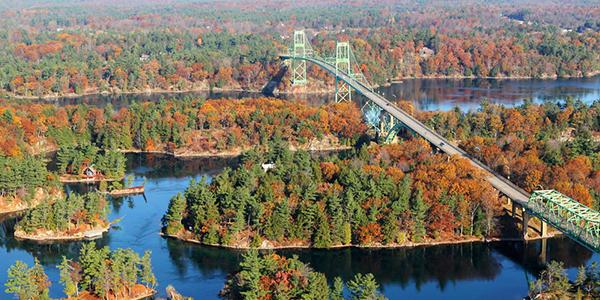Tolling Points
At 80 Years, the Thousand Islands Bridge System is a ‘Living, Breathing Thing’

The Thousand Islands Bridge System between the United States and Canada celebrates its landmark 80th birthday later this year. The commemorations are already beginning, with a news report last week in Northern New York State’s NNY Business.
“On a hot, windy Thursday in August 1938, a crowd of more than 25,000 people gathered on the rocky terrain of Wellesley Island, climbing atop boulders and craning their necks to get a glimpse of world history,” the publication recalls. The bridge opened at a time when the Second World War was just a year away, on the very day that Switzerland closed its borders to refugees without visas.
Against that backdrop, President Franklin D. Roosevelt’s signature statement was courageous and wise: “The best symbol of common sense is a bridge,” he told the opening ceremony. “Here a boundary is a gateway, and not a wall.”
Today, the idea of building gateways and not walls is just as timely, whether it refers to the spread of commerce and prosperity or the sharing of knowledge and cultures that keeps communities and societies vibrant.
At the time, the bridge was a major local happening in rural Jefferson County, with Canadian Prime Minister William Lyon Mackenzie King joining Roosevelt for the official opening of the Thousand Islands Bridge System. “It was huge for the region, because building a bridge system here had been talked about for many, many years, as early as the 1920s,” said Thousand Islands Bridge Authority (TIBA) Executive Director Rob Horr.
Echoes Past and Future
In case anyone thinks there’s anything new or unique in today’s battles to fund surface transportation infrastructure, NNY Business is here to tell you that the more things change, the more they stay the same.
“Early proponents of the bridge struggled for years to garner government approval and funding for the project,” the publication notes. “In fact, in those early planning years, many described the bridge as going ‘from nowhere to nowhere.’”
The other parallel was a government that wanted the infrastructure but lacked the funds to invest directly in a major construction project. “They realized very quickly after the Depression in ’29 that they were not going to be able to raise money for the bridge through government, because the government didn’t have any money,” Horr said.
A five-member, county-appointed Bridge Authority formed in 1933 and floated a $2.8-million bond for the project in February 1937. Construction on the banks of the St. Lawrence River began two months later.
A Sense of Pride and Ownership
Horr traces the bridge’s history decade by decade, from a challenging period during the war, to a resurgence in the 1950s when Interstate 81 and Canada’s Highway 401 brought more traffic to the facility. “By the beginning of the 1970s, bridge traffic had exceeded one million vehicles per year, and the North American Free Trade Agreement (NAFTA) of the 1990s brought that number even higher,” NNY Business notes. “Today, annual crossings exceed two million vehicles.”
But the bridge’s success is about more than just the numbers.
“We work very hard at promoting the bridge as a viable crossing for commercial and tourism traffic,” Horr told NNY Business. “It’s a unifying piece of linkage between the two countries—it’s more than just a conduit for cars and trucks.”
Among staff, board members, and surrounding communities, “the pride of ownership here is really just unbelievable,” he added. “It’s personal for all of us. It’s a love affair with a living, breathing thing, and we have the pleasure of maintaining it and keeping it safe.”
After a succession of maintenance and upgrading projects to keep the bridge in top working condition, TIBA is now looking to introduce an electronic toll collection system, combining E-ZPass for U.S. drivers with cash and credit options for Canadians. “Things are looking very bright for this crossing,” Horr said, but one bedrock principle endures:
“Bridges don’t just go over water or big canyons,” he said. “They also link people together.”
Get the latest on maintenance and upgrades for surface transportation infrastructure. Attend IBTTA’s Maintenance & Roadway Operations Workshop, June 24-26, 2018 in Harrisburg, PA.




0 Comments